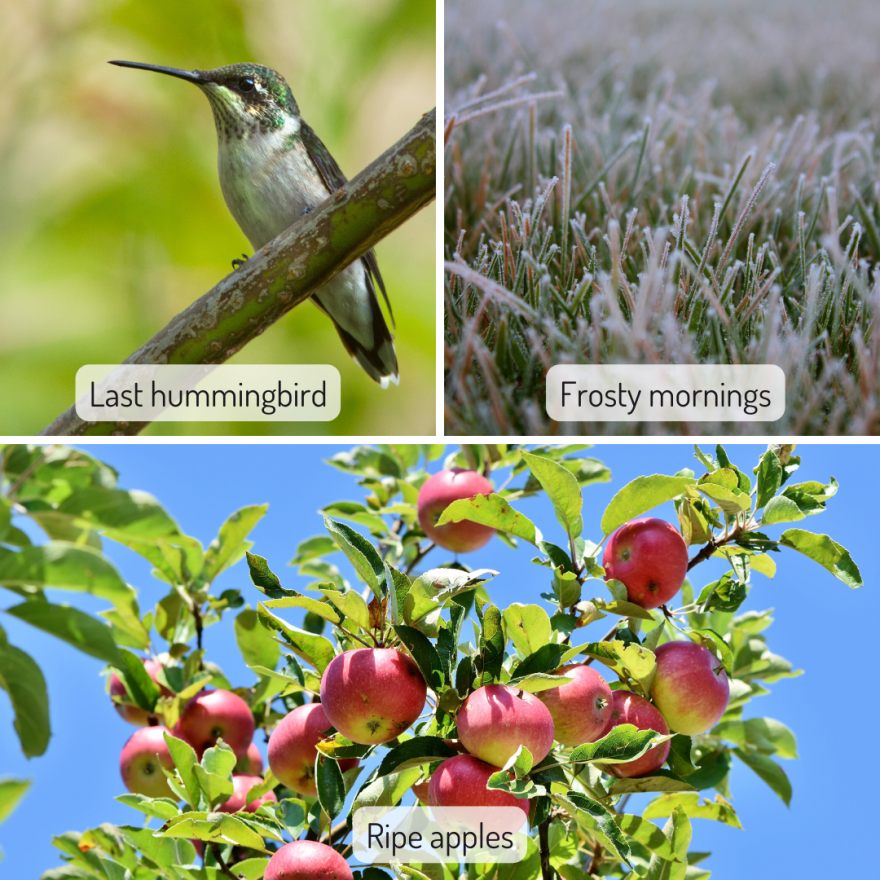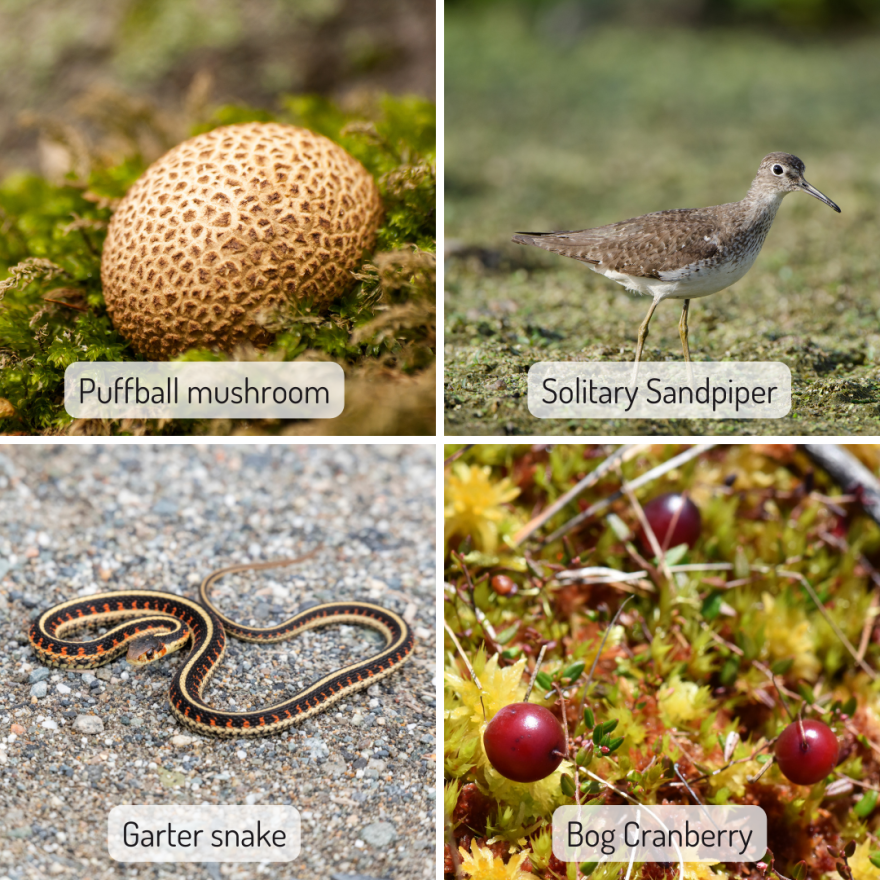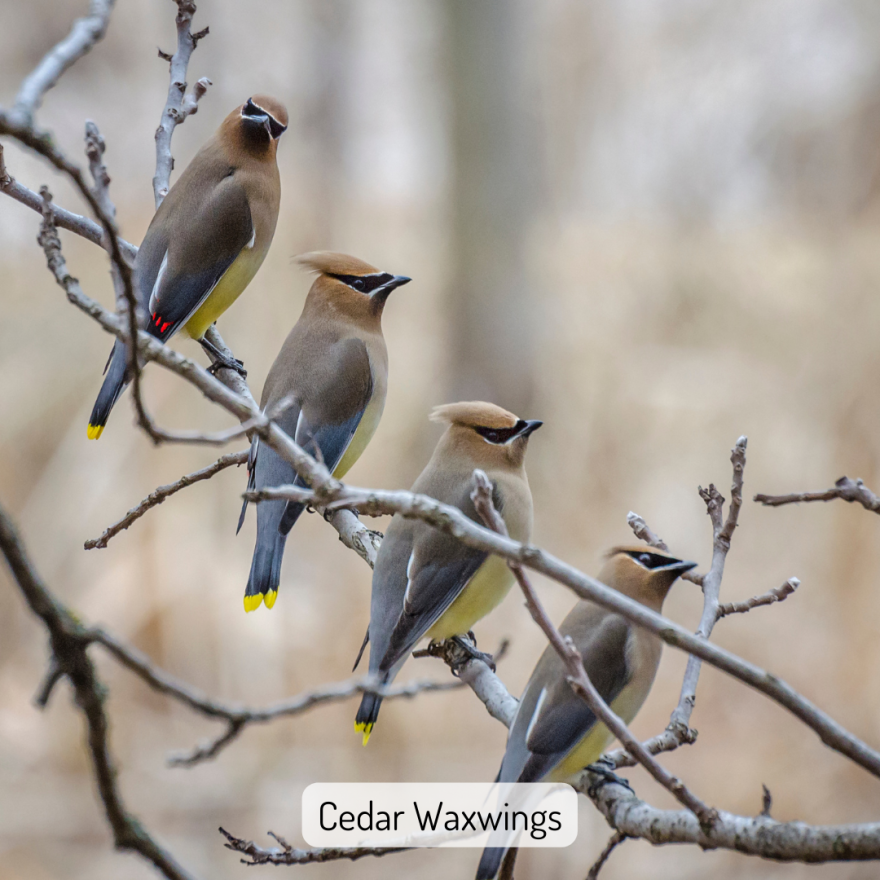It's another great week to be in nature! Our students, as always, had their eyes and ears open: let's hear what they discovered!
Our first report is from Abigail from Andrew Pierson's class at Lake of the Woods School. In the past week, the students heard grouse drumming and saw falcons, raptors, a flock of pintail ducks, a basking painted turtle, and lots of funnel webs along their school forest trail!
John congratulates them on their observations and reiterates a few key sightings. He adds that he's heard a few grouse drumming as well and saw a Broad-winged Hawk a week ago and a Red-tailed Hawk yesterday. [Want to hear more about fall raptor watching? Check out last week's interview with Laura Erickson!] John also notes that he doesn't get to see many pintailed ducks but always enjoys it when he gets the chance. The students were lucky, getting to see twelve pintails at once! The turtle they saw basking on a log will likely be burrowing down into the pond bottom soon to hibernate. They spend all winter holding their breath, waiting for spring. Keep note of when you see turtles in the fall- you never know when your last sighting of the year will be!
Ethan and Cameron are our reporters from Tami Worner's math class at TrekNorth School. This week, the theme concerned the distance between two points! They went outside to determine their pace lengths. Most students walked 10 feet in four or five steps, so they calculated that each step would be between 2-2.5 feet in length. Next, they tried to pace out 100 feet with their newfound knowledge; Kirsten and Caitlin were the closest!
While outside, they also made observations at the turtle pond. The maximum observations made was 69, and the minimum was 2 (they were busy watching the ducks!). They calculated the average (24.7) and the median (14), then determined that 50% of the class saw 14 or more things, and 50% saw less than 14.
Their observations included wind, cloud cover, temperature, anthills, tiny pine cones, and lots of green stuff in the pond! They wonder how their average number of observations will change through the seasons. "We're doing math in nature!"
John congratulates them on a great report and mentions that his father taught pacing to him as a kid. He still catches himself counting his steps as he walks through the forest. He concludes, "It's a really unique and interesting way to keep track of where you might be. So, check it out, and figure out what your pace is!"

Aubrey is our reporter from Collin Cody's class at Grand Rapids Elementary. They had a sunny day and 75 degrees on their phenology walk last week! The sugar maple seeds were still attached, as were the paper birch bracts (specialized leaves that hold the seeds during development). The butternut tree has turned 25% yellow. They found polypore mushrooms, a Blue Jay, tumbling snails, and orange jelly fungus! They also heard a tree frog, and John taught the students how to tell the difference between a leaf and a leaflet.
John says, "nice job!" on the report and mentions that they found the first sugar maple seeds to fall this season just yesterday. The polypore mushroom is "Still hanging in there, despite the attentions of fourth- and fifth-grade students," he adds. He also enjoyed seeing the snails and the orange jelly fungus on the dying log!

Bella and Tyler report from Matt Alleva's class at Hill City School. As is often true in nature, some species underwent significant changes while others stayed pretty much the same. The speckled alder and highbush cranberry trees showed very little change, but 15% of the red osier dogwood's leaves have changed color. The beaked hazel has dropped 10% of its leaves, and another 5% changed color. 20% of the leaves on their white bur oak have changed color. In addition to fall colors, the students have noticed squirrels and acorns digging and eating various nuts and acorns. The deer have been active, and there have been sightings of grouse, migrating geese, and even a video of a moose in Hill Lake! "It's a bird, it's a bee, it's phenology!"
John thinks the moose sighting is pretty exciting [I agree]! He adds that he's noticed some great color on the red osier dogwoods and the beaked hazels. The bur oak in his yard is about 50% colored, and the leaves fall off quickly after they change color. He notes that the same pattern holds true for many plants; birches also drop their leaves shortly after turning yellow. He reminds us to get out and enjoy it; things are changing pretty quickly!

Kira reports from Leigh Jackson's class at North Shore Community School. Their observations include:
- Sunday, 9/18: a student made apple crisp using apples from their tree! They also observed a late-migrating ruby-throated hummingbird.
- Monday, 9/19: Students found crabapples in the school forest but reported that they were pretty sour.
- Tuesday 9/20: Students could see their breath while waiting for the bus. Maple trees began to turn red and orange, while birch trees began to turn yellow. A student saw a hummingbird, likely the last of the season.
- Wednesday 9/21: Things really started to feel like fall!
- Thursday, 9/22: The fall equinox and the first day of autumn. A flock of 20 birds flew over in a V formation, likely migrating south. In their three sisters' garden, a student found a bee.
- Friday, 9/23: First morning with frost on cars.
The students also noticed lots of morning dew as they waited for the bus; some had seen frost. They observed deer eating apples off their trees, puffball and Coprinus mushrooms, lots of slugs in the grass, black flies hiding in window screens, skunks foraging for good in yards (and digging holes in the grass), and horses beginning to grow their winter coats. Students also harvested grapes and the last of the season's tomatoes. They mention that milkweed pods are almost ripe and advise on how to check them! If gentle pressure pops the seams open, the pod is ripe; if not, let it sit for a while longer. If you harvest the pods, be sure to leave some to reseed the area!
John congratulates the students on their many observations and mentions that he hasn't seen a hummingbird in two weeks! He agrees that there are LOTS of slugs out there right now.

Will brings the report from the DaVinci Acadamy's trip to Long Lake Conservation Center:
"During our visit to Long Lake Conservation Center this week we saw a few dragonflies, including a big blue one, and a pair of small red damselflies. Bumble Bees and Soldier Beetles were feeding on the remaining Golden Rod flowers. Our group saw LOTS of Garter Snakes in the woods. I think almost everyone in our group saw one. Our teachers think that they are out and feeding in preparation for winter. Olivia got bitten by a Garter Snake when she tried to pick it up, but she said it didn't hurt. Our group also saw a lot of Leopard Frogs and toads. Imani saw lots of Carolina Grasshoppers and a few crickets. EJ identified the Purple Asters, and Lilith found a Puffball mushroom. Flocks of Canada Geese were spotted flying south over Long Lake, and a Solitary Sandpiper joined us on the beach. Leaves are starting to turn colors, especially the red maples, birch and aspens. Our group saw lots of spiders, and Aubri even found and held a small slug in her hand. Aashi said she thinks it's cool that there is FREE drinking water in the bog, and everyone ate leaves from Labrador Tea Plant. We also found bog cranberries and ate them. It's a great time to explore the world and we want to remind everyone to unplug, get outside and to LIVE CONNECTED."
John echoes, "unplug, get outside, and live connected!" He's also seen many dragonflies, garter snakes, frogs, and Carolina grasshoppers. It's good to have so many things to look at as summer winds down!

Ben and Kaia report from Michelle Martin's class at Prairie Creek Community School. Temperatures have been incredibly variable over the last week, with a range of 44 degrees all the way to 92 degrees! Sunlight is getting shorter after the autumnal equinox; the class made a sun clock to check the shadows! The birds have been migrating through all week; they've seen ducks, geese, cranes, and hummingbirds (potentially including one late-migrating male). They did not see any herons but did see (and hear) chickadees, Blue Jays, Mourning Doves, and nuthatches.
For insects, the class found cicadas, dragonflies, Monarchs, sulfur butterflies, deer flies, paper wasps, and a mystery wasp with a long ovipositor. With this week's predicted frost, they wonder if this will end their insect sightings for the year! "Where do all the insects go?"
The mammals are preparing for winter; chipmunks, red squirrels, and grey squirrels are all quite active. During recess, the class followed a gopher track that wound around the playground; they even heard it digging!
The plants are also preparing for winter as their leaves change color and begin to fall. The maples are turning bright red and orange, and the soybeans are yellowed and dry. The crabapples are starting to sweeten! "One more step along the phenology journey!"
John says, "Those kids are on a good journey, for sure!" He reiterates a few of their observations and agrees it's a fantastic time of year.

Jaime from Bemidji sent us a note, saying, "I'm hearing cedar waxwings flock up and come through town."
John notes that Cedar Waxwings often flock to apple trees or showy mountain ashes this time of year! Keep an eye out; they're beautiful birds with a distinctive, wheezy, high-pitched call.

Remember that you can add your voice to this list! We would love to hear from you. Get in touch with me (smitchell@kaxe.org) or John (jlatimer@kaxe.org), or text 'phenology' to 218-326-1234.
For more phenology content, subscribe to our Season Watch newsletter!
Bonus: The software I use to convert audio to text sometimes messes up. Here are the highlights for this week:
"Phenology report" became "Funeral report." Something must have gone very wrong!






